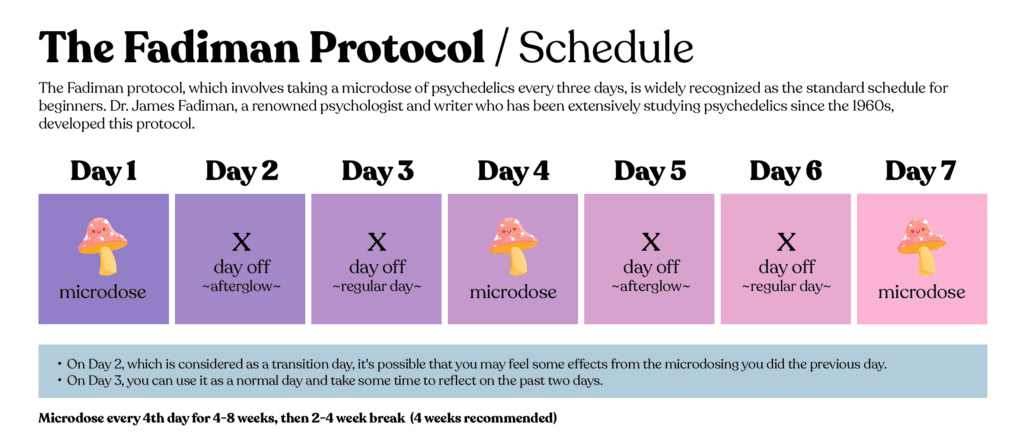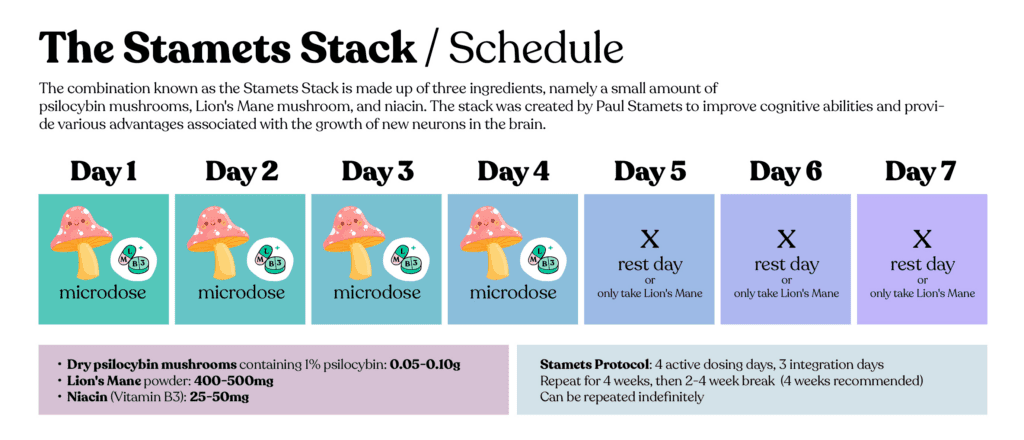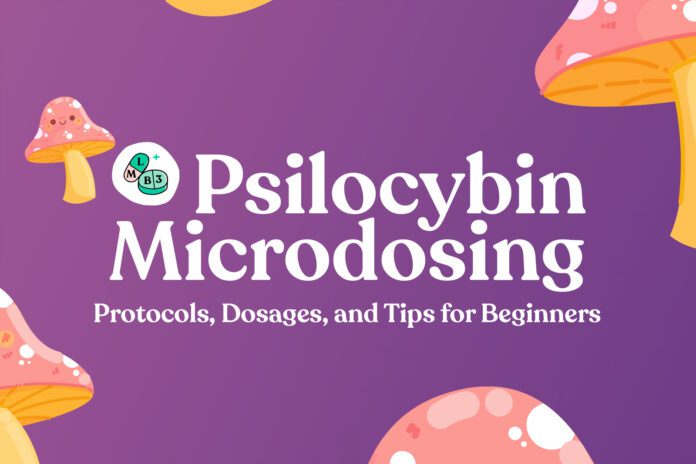Microdosing psychedelics, particularly magic mushrooms containing psilocybin, is becoming increasingly popular among those seeking subtle ways to enhance their creativity, focus, and overall well-being. But what are these “Microdosing Protocols” that people are talking about? In this article, we’ll break down what microdosing involves, its potential benefits, and provide a closer look at the various protocols, such as the Fadiman Protocol, Stamets Stack, and the Every Other Day approach. Each protocol has its own rhythm and philosophy, allowing individuals to experiment with psilocybin in a way that best suits their needs. Let’s take a moment to understand how following these well-structured routines can help promote a balanced and mindful state.
Table of contents
The Art of Microdosing: What’s the Big Deal?
Microdosing is the practice of consuming very small amounts of a psychedelic substance, usually about one-tenth to one-twentieth of a standard recreational dose. The goal of microdosing is to achieve subtle but noticeable benefits, such as enhanced creativity, improved focus, better mood, and increased overall well-being, without triggering the intense psychoactive effects or “trip” that come with a full dose. This practice has gained popularity in recent years, especially among people looking for natural ways to enhance their cognitive and emotional state.
Commonly used substances for microdosing include LSD (lysergic acid diethylamide) and psilocybin (the active compound found in magic mushrooms), both of which interact with serotonin receptors in the brain and can influence mood, perception, and cognitive functions in low doses. While LSD is synthetic, psilocybin is a naturally occurring psychedelic found in various species of mushrooms. In microdoses, users often report experiencing increased productivity, greater emotional clarity, and a deeper sense of connection with their surroundings—all without the visual distortions or hallucinations typical of higher doses.
Microdosing is not limited to classic psychedelics like LSD and psilocybin; some also explore microdosing cannabis or even non-psychedelic substances such as Lion’s Mane mushrooms or nootropics like phenibut. While these substances operate differently in the brain compared to psychedelics, they are sometimes included in microdosing discussions due to their potential to enhance cognition and emotional well-being in subtle ways.
Though still a relatively new field of study, anecdotal reports and emerging research suggest that microdosing may offer benefits such as enhanced problem-solving skills, increased motivation, better emotional balance, and even relief from anxiety and depression. However, it’s important to note that microdosing is not a one-size-fits-all approach. Different protocols, such as the Fadiman Protocol, Stamets Stack, or Every Other Day method, are designed to guide users in finding the optimal dosing schedule and substance that align with their unique goals and physiology.
Why Microdose?
Advocates of microdosing highlight several potential benefits that make it an appealing practice for those looking to enhance their daily lives:
- Enhanced Creativity: Many users report that microdosing helps unlock creative thinking and problem-solving abilities, allowing for a more fluid and imaginative flow of ideas.
- Improved Focus: With a small, controlled dose, some find it easier to maintain concentration and stay on task, reducing mental distractions and enhancing productivity.
- Reduced Anxiety: Research suggests that microdosing can help alleviate symptoms of anxiety by promoting a calmer, more balanced mental state. A study published in Scientific Reports supports the idea that low doses may help manage anxiety without the intensity of a full psychedelic experience. Source
- Elevated Mood: Users often experience a subtle uplift in mood, which can help combat feelings of depression or low energy, providing a more positive outlook on daily life.
- Increased Empathy: Microdosing can help foster a deeper sense of connection and empathy toward others, enhancing social interactions and overall emotional intelligence.
Microdosing Dosages
When it comes to microdosing, finding the right dosage is key to achieving the desired effects without overstimulation.
For LSD, a typical microdose ranges from 5 to 10 micrograms, which is about one-tenth of a standard recreational dose. This low level is usually enough to boost creativity, focus, and emotional clarity without inducing noticeable changes in perception.
For psilocybin mushrooms, the recommended microdose is between 0.1 to 0.3 grams of dried mushrooms. At these levels, users can experience subtle enhancements in mood and cognitive function, often described as a clearer mental state and a more grounded sense of well-being.
It is generally recommended to start at the lower end of the dosage range and gradually adjust as needed, keeping a log of your experiences to fine-tune your personal “sweet spot.” Always source substances from reliable and safe suppliers and be mindful of your own body’s responses to find the most beneficial and balanced approach to microdosing.
Preparing for Your Microdosing Experience
To get the most out of your microdosing practice, it’s important to approach it with careful preparation and intention. Here are some key steps to help you get started:
- Choose a Start Date: Pick a day to begin your microdosing practice when you have minimal commitments and can dedicate time to observe any subtle changes in mood, focus, or creativity. It’s ideal to start on a day when you have a clear schedule and can comfortably reflect on the effects.
- Set Your Intention: Before starting, take some time to define what you hope to achieve from microdosing. Are you looking to boost creativity, improve focus, reduce anxiety, or elevate your mood? Being clear about your goals will help guide your experience and allow you to track your progress more effectively.
- Select a Microdosing Protocol: There are several microdosing protocols available, each with a different approach to dosing frequency and schedule. Choose a protocol that aligns with your goals, lifestyle, and comfort level. Starting with a well-established protocol can help you find the rhythm that works best for you.
Microdosing Protocols
Microdosing is more than just popping a pill and waiting for the magic to happen. It’s essential to follow a well-structured protocol to get the most out of your experience. Below are some popular microdosing protocols to choose from:
1. Dr. James Fadiman’s Protocol
The Fadiman Protocol is a methodical approach to microdosing psychedelics, such as LSD and psilocybin mushrooms, with the primary goal of observing the effects of microdosing on an individual’s life. Dr. James Fadiman, an American psychologist and pioneer in psychedelic research, designed this protocol to emphasize the off-day “afterglow” effects, allowing users to fully integrate and appreciate the medicine’s impact during on-days.
The schedule looks like this:
- Day 1: First microdosing day
- Day 2: Afterglow / Transition day (no microdose)
- Day 3: Normal day (no microdose)
- Day 4: Repeat from Day 1

The Fadiman Protocol is a cyclical approach that involves taking a microdose every fourth day for a period of 4 to 8 weeks, followed by a break of 2 to 4 weeks.
Afterglow Effect
An essential aspect of the Fadiman Protocol is the emphasis on the “afterglow” effect. On the day after microdosing (Day 2), users often experience residual benefits, which may include enhanced mood, increased focus, and a sense of mental clarity.
Integration and Appreciation
By incorporating an extra off-day (Day 3), the Fadiman Protocol allows users to fully integrate and appreciate the effects of the medicine experienced on microdosing days. This pause gives individuals the opportunity to reflect on their experiences and better understand the impact microdosing has on their overall well-being.
Benefits of the Fadiman Protocol:
- Enhanced Productivity — One of the most remarkable benefits of the Fadiman Protocol is the potential for increased productivity. Users have reported feeling more motivated, creative, and focused on their tasks, leading to a more efficient and effective workday.
- Improved Emotional Regulation — Emotional well-being is a crucial aspect of a healthy, balanced life. The Fadiman Protocol has been praised for its potential to help individuals better regulate their emotions, resulting in reduced anxiety, stress, and mood swings.
- Boosted Focus — In our fast-paced world, maintaining focus can be a challenge. The Fadiman Protocol can help users sharpen their concentration and sustain attention on important tasks, making it easier to stay on track and accomplish goals.
2. The Paul Stamets Stack
After studying and working with medicinal mushrooms for over three decades, Paul Stamets devised a new microdosing method named the Stamets Stack, which aims to promote the growth of new connections in the brain and peripheral nervous system, known as neurogenesis. The Stack consists of three components: psilocybin, the legal mushroom Lion’s Mane, and the B vitamin niacin, taken in a repeating pattern of four days on followed by three days off.
Users of the Stamets protocol who microdose report similar mood, cognition, and performance benefits as those who follow the Fadiman protocol. However, some individuals believe that Lion’s Mane and niacin, as additional components of the stack, enhance psilocybin’s neurogenerative properties.
In 2019, Stamets’ recommendation for the Stamets Stack microdosing schedule shifted to four days on, three days off (4:3), as opposed to his earlier suggestion of microdosing for five consecutive days, followed by two days off (5:2). Microdosers have reported that taking two to three days off from the stack each week can help reduce tolerance to psilocybin.
Mycologist Paul Stamets suggests a more intensive protocol involving psilocybin and other supplements:
- Take a microdose of psilocybin every day for four days.
- Follow with three days off.
- Add lion’s mane mushroom and niacin supplements to enhance the effects.

Stamets’ protocol involves combining microdoses of psilocybin with Lion’s Mane and Vitamin B3/Niacin. To achieve the best results, this stacking method is most effective when following a “4 days on, 3 days off” schedule. During the pause days, Lion’s Mane can still be taken.
This is “The STACK,” a nootropic vitamin complex created by the Stamets Foundation for epigenetic neurogeneration. It is based on a 70kg (154lb) person consuming dry psilocybin mushrooms.
- Dry psilocybin mushrooms containing 1% psilocybin: 0.05-0.10g
- Lion’s mane mushroom mycelium powder: 400-500mg
- Niacin (Vitamin B3): 25-50mg. Please note that this method does not involve the use of non-flushing niacin.
The formula for Stamets’ protocol that involves combining microdoses of psilocybin with Lion’s Mane and Vitamin B3/Niacin, along with the recommended dosage and stacking schedule, was updated in May 2022.
Niacin is a vasodilator and essential for neural health, causing “flushing” and stimulating the production of Brain Derived Neurotrophic Factor (BDNF). Please note that the dosage ranges provided are general and may be adjusted for individual needs.
The fundamental premise of the “stack” is to create a nootropic routine that liberates individuals from their habitual thinking patterns and empowers them to engage in innovative and adaptive cognitive processes. According to Stamets, this approach can potentially facilitate the evolution of human consciousness. To achieve this goal, Stamets synergizes microdose to low-dose psilocybin mushrooms with other compounds that could enhance their effects.
3. Daily Microdosing Protocol
Microdosing every day is recommended for individuals seeking general cognitive enhancement, which may include increased mental clarity, sharper focus, and elevated mood. This schedule involves taking a microdose every day, consistently, for a specific period of time.
Pros of Daily Microdosing
- Consistent cognitive benefits: Daily microdosing provides a consistent level of cognitive enhancement without the need for “off” days, which may be preferable for individuals seeking constant benefits.
- Simplicity: The daily schedule is simple and easy to remember, reducing the likelihood of missed doses or scheduling errors.
Cons of Daily Microdosing
- Tolerance build-up: Consuming psychedelics daily may lead to a buildup of tolerance, which could diminish the effects of microdosing over time and potentially require higher doses to achieve the desired outcome.
- Lack of integration time: Daily microdosing leaves little room for users to integrate their experiences, which could limit personal growth and self-reflection.
4. Every Other Day Microdosing Protocol
Microdosing every other day is often recommended for individuals seeking psychological management of anxiety, depression, and PTSD. This schedule follows a pattern where the user takes a microdose on one day, skips the next day, and then resumes microdosing on the following day.
Pros of Every Other Day Microdosing
- Reduced tolerance build-up: By taking “off” days between microdosing sessions, users reduce the risk of building tolerance to the psychedelic substance.
- Integration time: Having days without microdosing allows for the integration of experiences and insights gained during the microdosing sessions, potentially enhancing personal growth and self-awareness.
Cons of Every Other Day Microdosing
- Inconsistent cognitive benefits: The every other day schedule may result in less consistent cognitive enhancement, as benefits could wane on non-microdosing days.
- More complex scheduling: The every other day schedule can be more challenging to remember and track compared to daily microdosing.
Finding Your Sweet Spot
Microdosing is a highly personal experience, and each individual’s response to psychedelics can differ based on factors like body chemistry, mindset, and environment. Therefore, it’s essential to find the dosage and protocol that work best for you. Start with a very low dose—typically between 5 to 10 micrograms of LSD or 0.1 to 0.3 grams of dried psilocybin mushrooms—and observe how your body and mind respond. Gradually adjust the dose if needed, ensuring you remain within the microdosing range to avoid any strong psychoactive effects. Pay close attention to your body’s signals, noting any shifts in mood, focus, or anxiety levels, and adjust your approach accordingly. Keeping a journal can be a helpful way to track your experiences and determine what “sweet spot” provides you with the most benefit without overstimulation or discomfort.
Microdose Magic Truffles
For those in Europe interested in microdosing with magic truffles, Shayana offers Microdose Magic Truffles – Microdosing XP, a convenient option designed for microdosing enthusiasts. These packs contain 1-gram portions of Psilocybe Mexicana truffles, offering a more straightforward and accessible way to microdose compared to psilocybin mushrooms or LSD.
While dried psilocybin mushrooms typically require careful weighing of 0.1 to 0.3 grams per microdose, the 1-gram truffle dose compensates for the lower concentration of psilocybin found in truffles. Truffles generally contain less psilocybin by weight compared to dried mushrooms, so a higher dosage is needed to achieve similar subtle effects.
Additionally, microdosing truffles come pre-portioned, eliminating the need for precise weighing and making them easier to use. Unlike LSD, which involves microdoses of 5 to 10 micrograms and requires accurate handling, truffles provide a natural, plant-based alternative with effects that enhance creativity, emotional balance, and focus without the intense visual or psychoactive effects associated with higher doses.

The Path to Self-Discovery
Microdosing represents a compelling and evolving practice that may offer individuals new ways to enhance creativity, focus, emotional balance, and overall well-being. By thoughtfully following established microdosing protocols, such as the Fadiman Protocol or the Stamets Stack, and staying attuned to your body’s responses, you can explore a path of self-awareness and personal development. It is essential to approach microdosing with a sense of curiosity and mindfulness, always prioritizing safety, proper research, and informed decision-making.
As interest in microdosing grows, our understanding of its potential benefits, limitations, and best practices will continue to expand. If you’re considering exploring the world of microdosing, remember to keep an open mind, stay informed, and carefully reflect on your experiences. With the right approach, microdosing might offer valuable insights and tools for unlocking new dimensions of your inner potential.
FAQ
How do I choose the right substance for microdosing?
It’s essential to choose a substance that you feel comfortable with and that is legal in your jurisdiction. Some popular choices include LSD, psilocybin mushrooms, and cannabis. It’s always a good idea to consult with a healthcare professional before starting any new regimen.
How can I ensure accurate dosing?
To ensure consistent and accurate dosing, use a digital scale for measuring and divide your doses into capsules or blotter paper. This will help you avoid any unintended high doses and make it easier to track your progress.
How long does it take to see the benefits of microdosing?
Everyone’s experience with microdosing is unique, and the time it takes to notice benefits can vary. Some individuals may notice positive changes within a few days, while others may need a few weeks. Consistency and patience are key.
Are there any side effects or risks?
Microdosing is generally considered safe when done responsibly and under the guidance of a healthcare professional. However, as with any substance, there’s always the potential for side effects or interactions with other medications. Some possible side effects include anxiety, nausea, or sleep disturbances. Always start with a low dose and monitor your body’s response.
Can I microdose while taking other medications?
It’s crucial to consult with a healthcare professional before microdosing, especially if you’re taking other medications. Some substances may interact with prescription medications or exacerbate existing health conditions.
